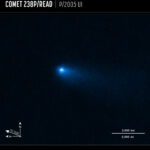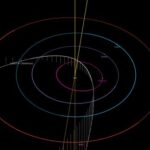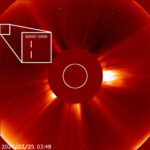Momenteel staat de periodieke komeet 103P/Hartley, alias Hartley 2, volop in de belangstelling, want hij is hoog aan de hemel zichtbaar voor kleine amateurkijkers. Maar behalve de amateurwereld kijkt ook de professionele wereld van ‘kometologen’ naar Hartley 2, want de sonde EPOXI – beter bekend als Deep Impact – vliegt op 4 november op 700 km langs de kern van de komeet. Emily Lakdawalla van de Planetary Society heeft een compleet tijdspad gemaakt van de scheervlucht en die laat ik hier zien:
| Datum / tijdstip (UTC) | Tijd tot dichtste nadering | Gebeurtenis |
|---|---|---|
| Oct 20 | -15d | Hartley 2 Earth closest approach. Comet Hartley 2 passes within 0.12 AU of the Earth. |
| Oct 26 19:00 | -9d | Preview press conference 11:00 PDT / 19:00 UTC |
| Oct 27 19:00 | -8d | Trajectory Correction Maneuver (TCM-21). Imaging ceases in order for the spacecraft to fine-tune its approach trajectory. Deep Impact is within 8.5 million km of the comet. |
| Oct 27 TBD | -8d | UStream broadcast |
| Oct 28 | -7d | Hartley 2 passes through perihelion. Hartley 2's closest approach to the Sun happens once every 6.4 years at a distance of 1.059 AU (close to earth's orbit). Comets are most active near perihelion. |
| Oct 28 | -7d | Approach Imaging. For 6 days, until 1 day before the flyby, Deep Impact acquires MRI and HRIVIS images every 2 minutes and HRIIR spectral scans every hour. Compared to the previous imaging phase, images are captured 2.5 times more frequently, while spectral scans are taken only half as often. Imaging is conducted for 16 hours, then turns to downlink data in a communications session lasting 8 hours. |
| Nov 2 21:00:00 | -1d 6h | Trajectory Correction Maneuver (TCM-22). This maneuver may be waved off on October 30 if the trajectory is within acceptable limits. |
| Nov 3 | -1d | Final pre-encounter data download |
| Nov 3 20:50:00 | -18h | High resolution imaging begins. During the closest approach, Deep Impact's high-gain antenna is pointed away from Earth, so all images are stored aboard the spacecraft, filling all available data volume. |
| Nov 4 13:50:00 (approx) | -1h (approx) | Deep Impact resolves Hartley 2 nucleus. One hour before closest approach, the spacecraft is at a distance of 45,000 kilometers. The nucleus is seen at a phase angle of 86°, or about half-phase. If estimates of the nucleus' diameter (about 1.2 kilometers) are correct, it should be about 10 pixels across in the HRIVIS, and 2 pixels across in the MRI. |
| Nov 4 14:00:00 | -50m | Spacecraft begins autonomous navigation. The spacecraft uses its own images to update its pointing and maintain the comet's proper position in its instruments' field of view. |
| Nov 4 14:30:00 | -20m | NASA TV broadcast begins. The broadcast focuses on the flight and science teams at the Jet Propulsion Laboratory, who are expected have contact with the spacecraft throughout the flyby, though data downlink does not begin right away. The broadcast continues until 16:10. |
| Nov 4 14:50:00 | -0m | Closest approach. Hartley 2 and Deep Impact are 1.064 AU from the Sun and 0.156 AU from Earth. At closest approach, the MRI will achieve about 7 meters per pixel, and the nucleus should appear about 170 pixels across. |
| Nov 4 15:20:00 | +30m | Data downlink begins; images posted to Web as available. Data does not begin flowing to Earth until the high-gain antenna can point in our direction. Five raw images from closest approach will be released on the mission website as they become available. Data downlink continues through November 6. |
| Nov 4 16:10:00 | +1h 20m | NASA TV broadcast ends. |
| Nov 4 21:00:00 | +6h 10m | Post-encounter press briefing on NASA TV. The press briefing is to include processed versions of the 5 images previously released. |
| Nov 6 | +2d | Outburst monitoring. After flyby downlink is complete, Deep Impact will return to monitoring Hartley 2's activity with MRI and HRIVIS images every 2 minutes and HRIIR spectral scans every 15 minutes for a period of 10 days. |
| Nov 16 | +12d | Outburst monitoring. Image frequency is reduced to MRI and HRIVIS images every 30 minutes and HRIIR spectral scans every 30 minutes for a period of 9 days. |
| Nov 30 | +26d | Hartley 2 data collection complete. The spacecraft is still active, collecting data for calibration purposes. NASA has recently solicited proposals for a further extended mission. |
Bron: Planetary Society.



